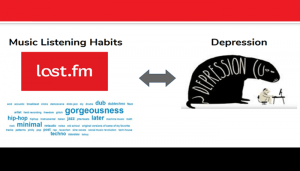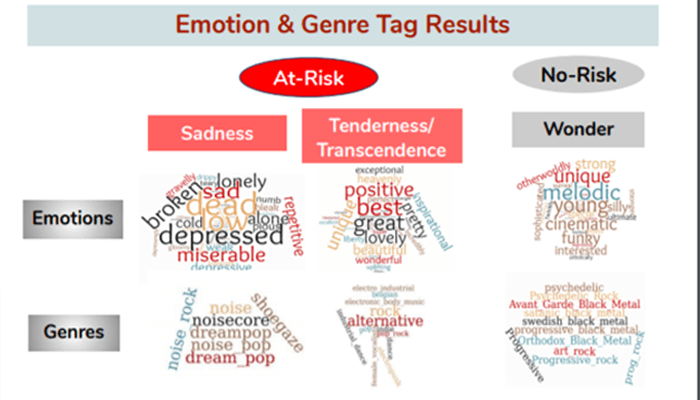While much of prior research linking depression with various musical engagement strategies has relied only on data collected via standard questionnaires, this is the first time that naturally occurring music consumption through streaming platforms has been examined to reveal insightful behaviour.
Individuals At-Risk of depression found listening more to music tagged with ‘Sadness’
They were also found listening to music belonging to subgenres such as Neo-Psychedelic Pop/Rock, and Indie music (Alternative Pop and Rock) which are tagged with ‘Sadness’ and ‘Tenderness.’
They use repeated listening of music predominantly representing Sadness as a coping mechanism.
Each time you access or use an online resource, you unwittingly leave behind a digital footprint. Same is the case when you listen to music online. As more and more people use music streaming applications, they inadvertently reveal a lot more than mere music listening habits. While these digital traces come in handy in improving user experiences and of course generating revenue for the music industry, academicians are now using the same tools to uncover patterns and trends in listeners who are at risk of depression.
Music: Mirrors The Self
Dr. Vinoo Alluri of the Cognitive Science department at IIITH strongly believes that listening to music is not a passive activity but one that holds a “mirror to the self”. With this credo, she and her students Aayush Surana and Yash Goyal have tried to identify music listeners with depressive tendencies from their listening histories. Shaking up the conventional belief of music listening being a means to only alleviate one’s mood, Prof. Alluri says that the inability to stop repeatedly listening to (sad) music, using it as a tool for avoidance and using music as a coping mechanism means one could wallow in an unhappy state too. Terming it as a maladaptive use of music, she says, “This may also be a useful way of mirroring negative emotions and states, so they listen to music which matches their (negative) states. While it can be cathartic sometimes, repeatedly being in such states may be an indicator of potential underlying mental illness and this is reflected in their choice and usage of music.” An intervention that allows for a change in music listening behaviour of such users is possible first when they are identified and when their listening habits are uncovered. The latter especially is useful for suggesting or making music recommendations that may break the pattern of ruminative and repetitive music usage eventually leading to a more positive outcome.

Analysing Social Tags
In the study, titled “Tag2risk: Harnessing Social Music tags for characterizing depression risk” over 500 individuals’ music listening histories were elicited from the music streaming platform last. Fm in addition to their responses on standard questionnaires assessing their traits and states, namely the Kessler’s Psychological Distress Scale (K-10), the Healthy-Unhealthy Music Scale (HUMS), and personality questionnaires. The K-10 or the Kessler’s Psychological Distress Scale is a measurement of psychological distress with higher scores indicating higher distress. The HUMS is a tool which measures music engagement as an indicator of mental well being, that is, if music is being used as a mood regulator (healthy) or not (unhealthy). “We chose HUMS and the personality questionnaires because we wanted to see if the distress in individuals was a temporary state or a general tendency. There’s a strong correlation between personality traits and the Kessler’s score; those who score high on neuroticism are the ones who are generally easily stressed and anxious. They also score high on the unhealthy HUMS score. So, we were testing the validity of data,” explains Prof. Alluri who is the main overseeing author of the paper. Surana and Goyal who are the joint first authors of the paper, particularly looked at social tags or labels that listeners apply to songs, albums or artists. A combination of tags applied by thousands of listeners provides a comprehensive view of the artist or soundtrack in terms of musical genre, emotions and experiences evoked and so on.
‘At Risk’ Group Prefers Sad Music
To begin with, the researchers filtered tags for each song track and picked only those that represent emotions associated with the quality of music. When these tags were mapped onto a Music-Emotion Model, a pronounced difference in the music listening profiles of individuals ‘At Risk’ of depression and those with ‘No Risk’ was found. Those at risk of depression were found predominantly listening to music tagged with emotions such as Sadness. Sadness is representative of being low on energy or activity and low on valence or pleasantness. In fact other related terms such as dead, low, depressed, miserable, broken, and lonely were also associated with Sadness. But what kind of music was this, associated with such sad descriptors? Again, social tags related to genre showed that these individuals were reaching out to Alternative, Neo-psychedelic pop/rock, Avant garde, and Dream-pop. In the case of the No-Risk group, their music listening history was characterized by tags such as positive valence and higher arousal associated with emotions like Wonder. Interestingly, they also showed a predilection to high energy music such as Heavy metal and Progressive Rock genres.
While statistically the results validated the researchers’ hypothesis linking music listening styles as predictors of psychological distress, what puzzled them was that despite being acoustically different, heavy metal music as well as a soppy love song could get clubbed together under the same category as Wonder. Plus, since emotions are dynamic and fluctuate over time, the need to investigate music consumption based on its acoustic features over differing periods of time was also felt.

Studying Acoustic Features
To study the association between depression risk and music consumption via acoustic features, this time the researchers used Spotify’s public API to extract features such as danceability, loudness, speechiness, liveness, instrumentalness, tempo and others from the tracks of the participants’ music listening histories. In addition to this, emotion features such as valence and energy were also extracted. Each soundtrack was further categorized into quadrants of Happiness, Sadness, Anger and Tenderness. Previous studies have found an association between dynamic measures such as variability, instability and inertia with depression. This means that an At-Risk individual will tend to stay in a depressive state for quite some time (high inertia) or have wild fluctuations in moods and/or behaviour (high emotional variability). The aim of the study was to see if this was reflected in their choice of music. In other words, in the context of music consumption, would it imply that someone with high instability will record higher fluctuations with respect to the features/emotions of soundtracks with interspersed inertia in certain emotional (preferably sadness) states? Turned out it did.
In their new study titled, “Static and Dynamic Measures Of Active Music Listening As Indicators of Depression Risk”, the researchers found that the greater the risk of depression, the lesser they deviated from listening to music associated with specific levels of Instrumentalness (or presence of lyrics) and tend to be resistant to change when listening to such music over time. This corroborated their previous work which showed At-Risk individuals gravitating towards music with obscure vocals. It was also found that individuals at risk for depression showed higher inertia in their own internal states with respect to tracks that were marked by Sadness. Demonstrative of how such individuals use repetitive listening of this type of music as a coping mechanism, a positive association between K10 scores and a Repetitiveness Index was unearthed too. “In terms of acoustic features only, on an average there wasn’t much of a difference in music listening between At Risk and the No-Risk groups. But there was a difference in the manner in which the two groups used music as coping mechanisms. Misery loves company. If music acts as a social surrogate to get you through your lows then by all means do so. We wouldn’t want to label music and say ‘Sad music is bad for you, peppy is good’. It’s not about ‘what’ but more about “how” music is consumed. That said, it is essential to be self-aware of your listening habits; coping by only listening to music for extended periods of time may not be ideal,” explains Dr. Alluri.
The first paper has been accepted at the 21st prestigious International Society for Music Information Retrieval conference due to be held virtually in October 2020. It is the world’s leading research forum on processing, analyzing, searching, organizing and accessing music-related data.
The second paper has been accepted at the Satellite workshop Speech, Music and Mind 2020: Detecting and Influencing Mental States with Audio of the prestigious International conference Interspeech 2020 to be held virtually in October as well.
Read more about their work here and here.

Sarita Chebbi is a compulsive early riser. Devourer of all news. Kettlebell enthusiast. Nit-picker of the written word especially when it’s not her own.


Next post